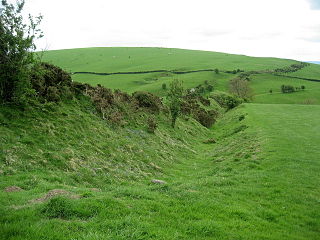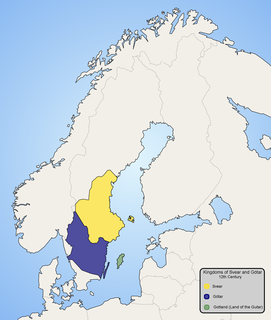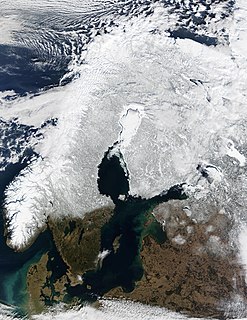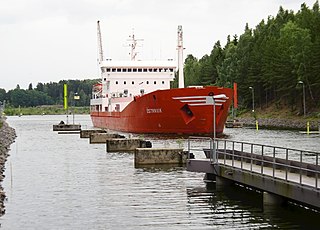
Götavirke (Geatish Dyke) are the remains of two parallel defensive walls going from north to south between the villages of Västra Husby ( 58°29′N16°10′E / 58.483°N 16.167°E ) and Hylinge ( 58°28′N16°10′E / 58.467°N 16.167°E ) in Söderköping Municipality, Östergötland, Sweden. The walls cover the distance between the lakes Asplången ( 58°30′N16°08′E / 58.500°N 16.133°E ) and Lillsjön ( 58°28′N16°10′E / 58.467°N 16.167°E ). North of Asplången there are remains of several ancient hill forts that may have been part of the defensive line. South of Lake Lillsjön, the terrain is so hard to pass that it hardly needed any defenses.

Västra Husby is a locality situated in Söderköping Municipality, Östergötland County, Sweden with 486 inhabitants in 2010. There are many places in Sweden called Husby, making it easily mixed up with the suburb in the capital Stockholm.

Söderköping Municipality is a municipality in Östergötland County in southeast Sweden. Its seat is located in the city of Söderköping.

Östergötland is one of the traditional provinces of Sweden in the south of Sweden. It borders Småland, Västergötland, Närke, Södermanland and the Baltic Sea. In older English literature, one might also encounter the Latinized version, Ostrogothia. The corresponding administrative county, Östergötland County, covers the entire province and parts of neighbouring provinces.
The walls seem to be constructed to protect the Geatish heartland around today's Linköping from attacks from the Baltic Sea. Archaeological excavations have shown that the walls were constructed ca 800. Defense constructions were also built along the 20-kilometer narrow inlet Slätbaken that stretches from the Baltic Sea to Götavirke, and even pass it during the Viking Age when the water level was 1.5 meters higher. The measures that Geats had taken to protect the route have no match in Viking Age Sweden. [1]

Linköping is a city in southern Sweden, with 158,841 inhabitants as of 2018. It is the 7th largest city in Sweden. It is the seat of Linköping Municipality and the capital of Östergötland County. Linköping is also the episcopal see of the Diocese of Linköping and is well known for its cathedral. Linköping is the center of an old cultural region and celebrated its 700th anniversary in 1987. Dominating the city's skyline from afar is the steeple of the cathedral, Domkyrka.

The Baltic Sea is a marginal sea of the Atlantic Ocean, enclosed by Denmark, Estonia, Finland, Latvia, Lithuania, Sweden, northeast Germany, Poland, Russia and the North and Central European Plain.
The wall supported a wooden pale and behind it are traces of a military road, which makes it similar to the Danevirke protecting the contemporary town of Hedeby. No Viking Age towns are however known in the vicinity of Götavirke.

The Danevirke is a system of Danish fortifications in Schleswig-Holstein, Germany. This historically important linear defensive earthwork across the neck of the Cimbrian peninsula was initiated by the Danes in the Nordic Iron Age at some point before 500 AD. It was later expanded multiple times during Denmark's Viking Age. The Danevirke was last used for military purposes in 1864 during the Second War of Schleswig.

Hedeby was an important Danish Viking Age trading settlement near the southern end of the Jutland Peninsula, now in the Schleswig-Flensburg district of Schleswig-Holstein, Germany. It is the most important archaeological site in Schleswig-Holstein.












